
94% of researchers rate our articles as excellent or good
Learn more about the work of our research integrity team to safeguard the quality of each article we publish.
Find out more
ORIGINAL RESEARCH article
Front. Plant Sci. , 31 January 2024
Sec. Crop and Product Physiology
Volume 15 - 2024 | https://doi.org/10.3389/fpls.2024.1336884
This article is part of the Research Topic Novel Ways and Methodologies to Improve Crop Yield View all 20 articles
Introduction: Fertilizer management is crucial to maintaining a balance between environmental health, plant health, and total crop yield. Farmers are overutilizing fertilizers with a mind set to enhance the productive capacity of the field, which adversely impacts soil fertility and causes serious environmental hazards. To mitigate the issues of over-utilization of fertilizers, controlled-release fertilizers were developed using nitrogen fertilizer (ammonium chloride) loaded on cellulose nanofibres (named CNF*N).
Methodology: In this study, the effects of CNF*N were compared with commercial nitrogen fertilizer (ammonium chloride) on Vigna radiata (Mung) under greenhouse conditions. The pot experiment was conducted using six treatments: first treatment was control, where the plant was cultivated (T1); second treatment was T2, where the plant was cultivated with CNF to determine the impact of CNF on the plant; third was T3 where commercial ammonium chloride (24 mg/ 2 kg soil) was added to the plant; fourth was T4, where the plant was loaded with CNF, viz. CNF*N contains 4.8 mg of nitrogen; fifth was T5 CNF*N pellet contains 12 mg of nitrogen, and the last sixth treatment (T6) where CNF*N pellet containing 24 mg of nitrogen.
Results: It indicated that the growth parameters were best achieved in T6 treatment. Plant height was at its maximum in the T6 treatment (44.4 ±0.1cm) after the second harvest, whereas the minimum plant height was observed in T1, which was 39.1 ±0.1 cm. Root-to-shoot weight ratio was also maximum in T6 (0.183± 0.02) and minimum in T1 (0.07± 0.01) after second harvesting. The significant difference among the treatments was determined with Tukey’s honestly significant difference (HSD). The nitrogen content (available and total) was significantly higher in the T4, T5, and T6 treatments (0.22, 0.25, and 0.28%) as compared to the control treatments (T1 (0.12%), T2 (0.13%), and T3 (0.14%) during the second harvesting stage (90 days), as nitrogen plays a crucial role in the development of vegetative growth in Vigna radiata. The rate of controlled-release nitrogen-fertilizer was found to be optimal in terms of plant growth and soil nutrients; hence, it could potentially play a crucial role in improving soil health and the yield of the crop.
Agriculture is the principal industry responsible for the economic growth and the primary means of subsistence in rural regions of the developing countries like India. Further, to fulfil the food demand of ever-increasing population and to enhance crop yield, excessive fertilizers are utilized, even though a major portion of these fertilizers are lost to the environment through hydrolysis, photolysis, or volatilization (Shojaei et al., 2019). To mitigate the issues of leakage of fertilizer, controlled release fertilizers were developed that allow the control release of fertilizer on the targeted site through diffusion process. Controlled release fertilizer based on CNF was used on Mung bean (Vigna radiata L. Wilczek). Vigna radiata is one of the crops drastically affected due to inadequate and unbalanced fertilizer (Jain et al., 2007; Asaduzzaman et al., 2008). It is widely known as green gram or bean, belongs to the legume family Phaseoleae and is presumed to be a native crop of India (Ikraam, 2002; Hua, 2006; Hussain et al., 2011; Alemu, 2016; Cheng, 2016). When soil nitrogen levels are low, a modest amount of nitrogen fertilizer is applied to encourage rhizobia development and boost the growth of vigorous Vigna radiata seedlings (Yayeh et al., 2017). Vigna radiata cannot properly fix atmospheric nitrogen during the early development phases before the branches emerge because it has few or no rhizobia. Nitrogen is one of the key components of amino acids and proteins; phosphorous promotes root development and plays a key role in metabolic processes, while potassium is important for physiological processes like osmoregulation, assimilate transport, and enzyme activation (Yanni et al., 2001). Increased nitrogen fertilizer treatment during the early growing stage encourages vegetative growth and fosters circumstances that are favourable for high yield. Rhizobia proliferate, and the plant’s capacity to fix atmospheric nitrogen rises; however, during the late development stage, if too much nitrogen fertilizer is used, rhizobia activity gets limited. And the development of the flower bud and the subsequent yields are hampered in such circumstances (Sadeghipour et al., 2010). Additionally, the quality of agricultural produce and the microbiota of the soil have been found to be impacted along with the nutrient holding capacities, nutrient usage efficiency, soil fertility degradation, and increased soil-borne diseases (Naeem et al., 2006).
Therefore, a balanced fertilizer dose application and careful manure management can increase Vigna radiata production and quality (Krishnamoorthy and Rajiv, 2017). Sustainable agriculture solutions to improve the bioavailability of nutrients to plants entail increasing a farmer’s net gains from agricultural output. This may be accomplished by utilizing biopolymers-based controlled-release fertilizers (Nair et al., 2019). This study involves the cellulose nanofibre (CNF)-based nitrogen-fertilizer, in which CNF works as a carrier and delivers the fertilizer in a controlled manner. The purpose of this study is to guide the crop production of Vigna radiata using CNF*N as a controlled-release fertilizer system with the aim of overcoming the limitations of traditional fertilizers and assisting effective Vigna radiata cultivation. For this, the greenhouse experiment was performed, where six different treatments in 12 replicates were given and their plant physiological parameters (plant length, leaf area, root-to-shoot ratio, primary branches, pH, electrical conductivity, organic carbon, nitrogen analysis, etc.) were determined.
Rice straw was collected from the district of Mathura, Uttar Pradesh. The cellulose nanofibres derived from rice straw were obtained through TEMPO-oxidation, as described in our previous study (Sharma et al., 2023b). Fertilizer was procured from the chemical lab at TERI. Vigna radiata seeds (Morya variety) were purchased from the local market in Gurgaon, India. The soil used in the experiment was collected from a farm located in TERI Gram, Haryana, India (28.4275° N, 77.1465° E) from a depth of 0-20 cm.
Soil was sieved and autoclaved three times to eliminate unwanted contaminants was and was characterized for physicochemical parameters such as pH using pH meter, electrical conductivity by conductivity meter, organic carbon, total and available nitrogen by Kjeldalh method as mentioned in our previous study (Sharma et al., 2023c) (Table 1).
Greenhouse pot trials were performed at Polyhouse 3 of the TERI-Deakin Nanobiotechnology Centre, TERI-Gram, Gurugram, India (28.4275° N, 77.1465° E) (Supplementary Figure S1). The study was conducted for three months, beginning in the fourth week of March 2023 and continuing until the fourth week of June 2023 maintained with temperature of day/night (27/25°C). As the region had the climate characteristics of plains, irrigation was performed on a daily basis until the end of the study.
The Morya variety of Vigna radiata is high-yielding and has a high tolerance to powdery mildew diseases caused by Podosphaera fusca and Erysiphe polygoni (Yin et al., 2018). The greenhouse study was conducted following the method of Yin et al. with slight modifications (He et al., 2020). The soil was autoclaved three times and added to sterilized 2-kg pots. Prior to the pot study, the Vigna radiata seeds of the cultivar were investigated for their viability. The seeds were washed with Tween 20 detergent for 3 min followed by 3 to 4 washings with water. Further, surface sterilization was performed with 0.01% HgCl2 for 1 min followed by five washings with autoclaved water. The surface-sterilized seeds were placed in the petri dish, and their germination was checked. After seed germination, one seed per pot was sown and evaluated further (Supplementary Figure S2).
The pot experiments using controlled-release nitrogen-based fertilizer were conducted with six different treatments, and their details are mentioned in Table 2 with the aim to determine the overall growth of Vigna radiata. All treatments were set up in 12 replicates (72 trial pots) for two harvestings. In the first harvesting stage, 36 pots were harvested after 45 days of plantation when the trifoliolates were developed, and the second harvesting stage was performed on the 90th day of plantation when the pods with sufficient seeds were developed.
For harvesting, the whole plant was carefully uprooted from the soil, retaining the fine roots. This was followed by the washing of the roots to remove the adhered soil several times with distilled water. The plant shoot and root were separated and oven-dried for 3 days at 55°C. The shoot and root dry weights were recorded, and the roots-to-shoot ratio was determined. The leaves on the plant were counted; leaf area was calculated, and the number of primary branches was also counted for both the first and second harvesting stages (Sharma et al., 2020). The soil pH and electrical conductivity were analysed using a pH metre and a conductivity metre, respectively. The conductivity metre was calibrated with a standard KCl solution, whereas the pH metre was calibrated using several pH buffers (4.0, 7.0, and 9.0) (Potdar et al., 2021).
For nitrogen estimation in soil, the Kjeldahl method was used, and the distillation process was employed, where 20 g of soil, 100 ml of potassium permanganate, and 100 ml of sodium hydroxide were added into a digestion tube. The released ammonia was collected in boric acid using a distillation unit, where it forms ammonium borate and gets collected in a conical flask. The ammonium borate solution was titrated with sulfuric acid (0.1N H2SO4) till the color changed from pink or red to green (Lelago et al., 2016). The percentage of nitrogen was calculated using Equation 1:
Where, V is acid used in the titration (ml), and N is the normality of the standard acid.
All plant growth data and soil data were analysed by one-way analysis of variance (ANOVA) with the factors in the treatment analysis. The significant difference among the treatments was determined with Tukey’s honestly significant difference (HSD) using OriginPro 8.5.
The soil physico-chemical parameters were checked before the initiation of the pot studies. The results obtained are tabulated in Table 1. The soil pH was analyzed to be 7.24, which was moderately neutral. According to the South African Department of Agriculture, Forestry, and Fisheries, the best production of Vigna radiata requires sandy loam soil with good drainage at a pH of 6.3–7.2. Neutral soil with a pH of 6.7–7.3 and silty clay soil texture might have fewer drainage problems for Vigna radiata. The electrical conductivity (EC) of the soil was monitored to be low (140.0 ± 0.05 µS/cm) indicating the soil was free of salts. Organic carbon and nitrogen contents were also depicted in the table below. The soil was deficient in nitrogen and hence appropriate for studying the nitrogenous fertilizers effect (Mota et al., 2021).
Plant height, as a principal agronomic character, is the length of the Vigna radiata plant and is closely related to the yield of the crops. Plant height increased with the increase in CNF*N, as checked after both the first (after 45 days) and second (after 90 days) harvesting. The maximum height of the plant was observed in treatment 6 (T6), where 50 mg of CNF*N was added, as compared to control treatment 1 (T1), where no fertilizer was added. After first harvesting, the height in T6 was 40.4 ± 0.04 cm as compared to 34.8cm ± 0.08 in T1. T2 treatment showed 35.1 ± 0.09, 36.2 ± 0.1 in T3, 38.2 ± 0.05 in T4, and 39.2 ± 0.08 in T5. After second harvesting, the height in T6 was 44.4 ± 0.1 cm while the height in control (T1) was 39.1 ± 0.1 cm (Figure 1). Other treatments indicated 39.1 ± 0.1 in T2, 39.0 ± 0.2 in T3, 41.6 ± 0.1 in T4, and 43.5 ± 0.1 in T5. Thus, the increase in plant height is probably due to increased nitrogen content until the 90th day, as T6 treatments represent controlled-release fertilizer which led to enhanced root development and crop growth. All the measurements were the average of six replicates of each treatment.
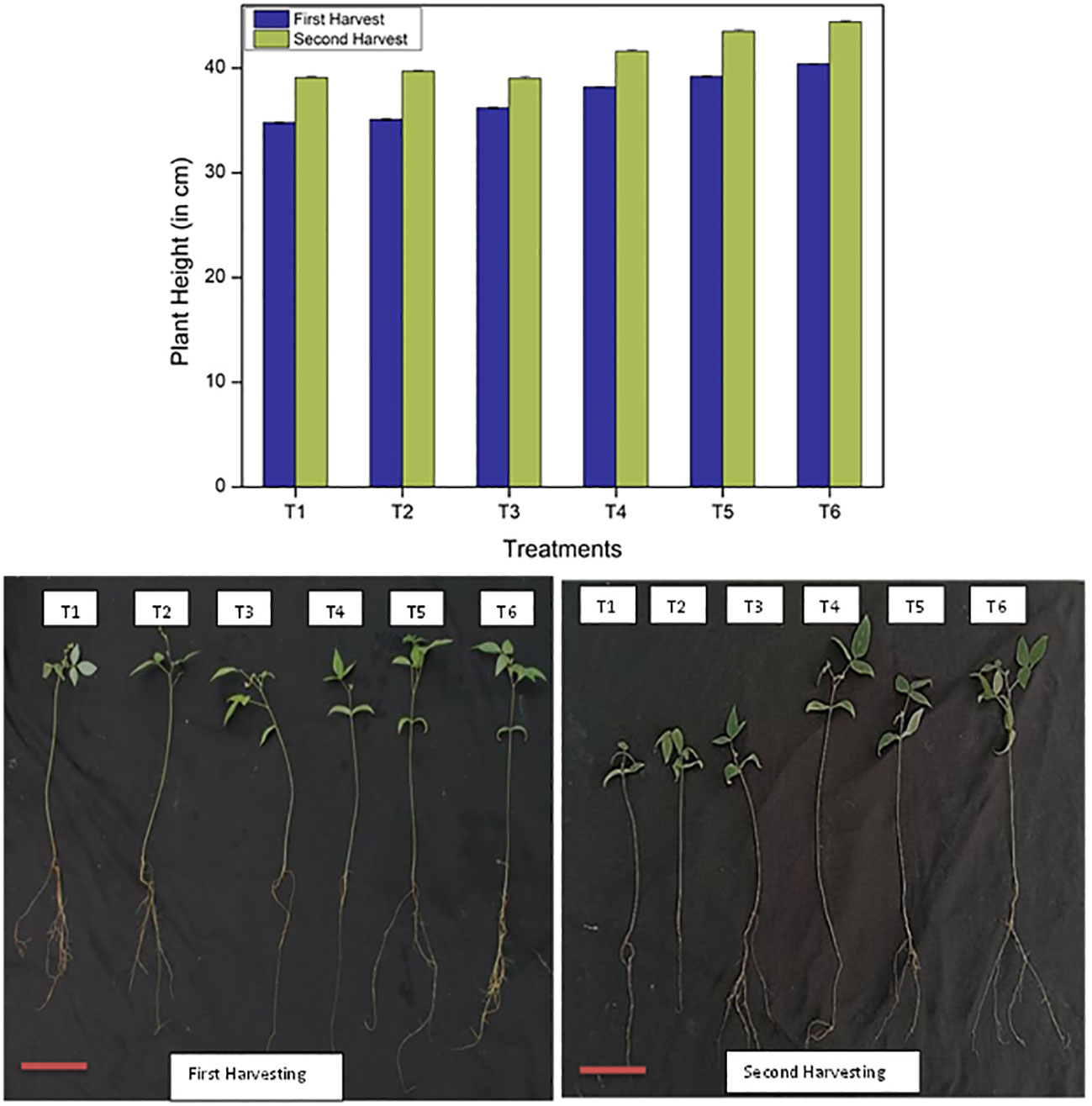
Figure 1 Image of the plants after the first (45 days) and second (90 days) harvesting stages showing the effect of six different treatments on the phenotype and height of the plant All the measurements were done in replicates of six plants (bars represent standard deviation; scale bar = 1 cm).
The dry weight of plants tends to provide a precise assessment of plant biomass by removing changes caused by water content. Plant performance in response to photosynthetic ability, nutrition, and environmental factors can be directly correlated with plant total biomass. The details of the root and shoot dry weights of plants are represented in Table 3.
The ability of a plant to absorb water and nutrients from its surroundings is dependent on its roots. A healthy root system is essential to the overall health of the plant. The root-to-shoot ratio is an important parameter to monitor plant health. The root-to-shoot ratio was highest for T6 treatment during both the first (0.09± 0.01) and second harvestings (0.183± 0.02) as compared to the control T1 (without any fertilizer) with the lowest root-to-shoot ratio during the first (0.03 ± 0.01) and second (0.07± 0.01) harvestings. Other treatments T2 showed 0.04± 0.01, 0.039± 0.01 in T3, 0.05± 0.01 in T4, and 0.06± 0.01 in T5 root-to-shoot ratio in first harvesting followed by second harvesting, which showed 0.08± 0.01 in T2, 0.08± 0.01 in T3, 0.10± 0.02 in T4, and 0.11± 0.01 in T5 as represented in Figure 2.
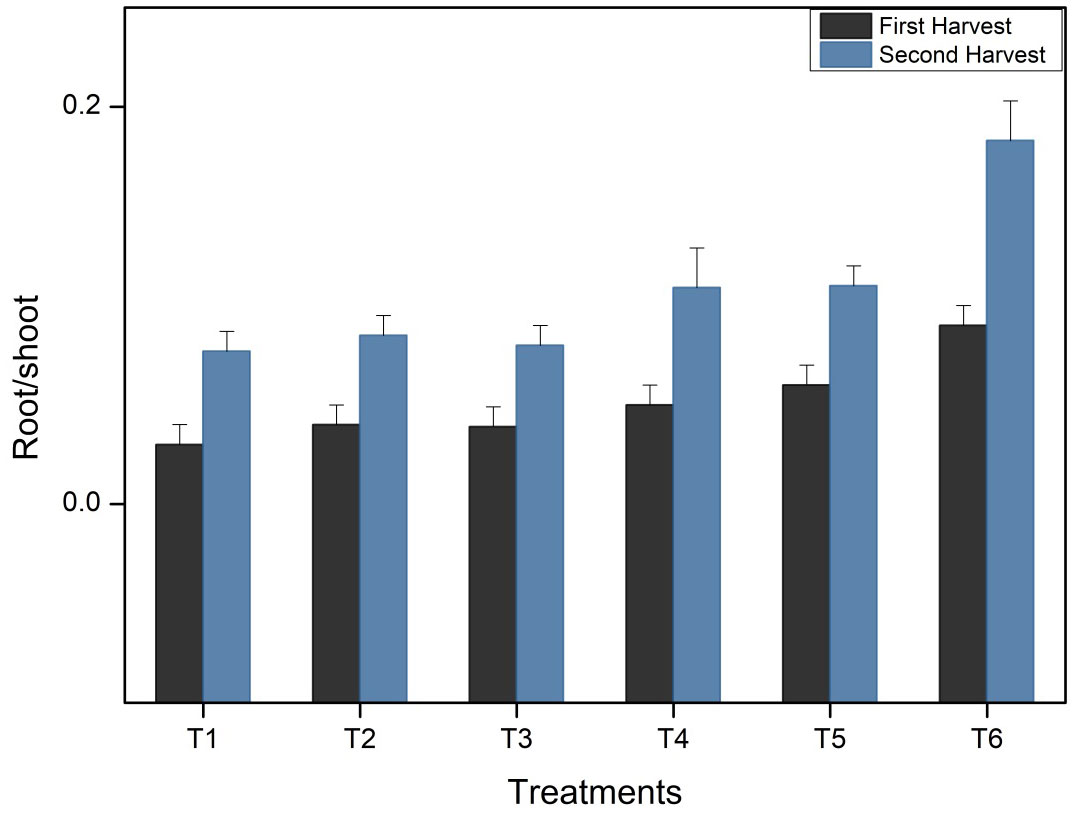
Figure 2 Root-to-shoot ratio of Vigna radiata plants at first and second harvesting stage (Bars representing standard deviation).
Figure 2 represents the results of the dry weight of the root-to-shoot ratio of Vigna radiata with six different treatments (T1-T6) after 45 and 90 days. The outcomes of the study revealed that treatment T6 showed significantly better results as compared to the other treatments, and the plants harvested had better vigour and health (Figure 3).
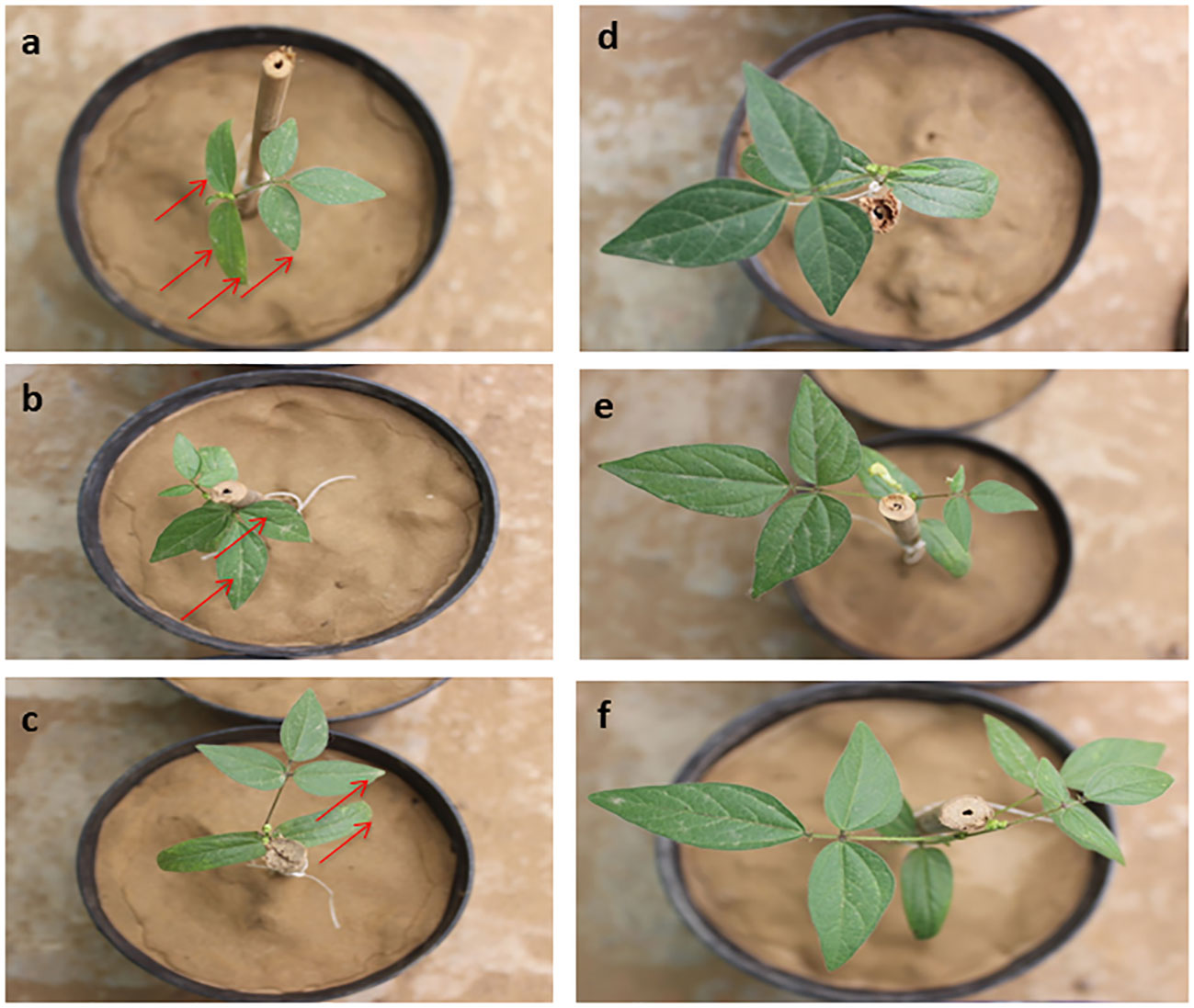
Figure 3 Photographs of the Vigna radiata with different soil treatments at the second harvesting stage or after 90 days of growing phase: (A) T1, (B) T2, (C) T3, (D) T4, (E) T5, and (F) T6, where the red arrow represents the yellow spots on the leaf due to nitrogen deficiency.
The number of leaves per plant is significantly impacted by the time of the fertilizer application and the type of the fertilizer. The highest number of leaves (7 in the first harvesting stage and 8 in the second harvesting stage) were found in the T6 treatment where 50 mg of CNF*N was added to the soil. In control T1 (without any fertilizer), 3 leaves were found after the first harvesting stage, and 4 leaves were obtained after second harvesting stage. Other treatments, such as T2, showed 4, 4 in T3, 5 in T4, and 6 leaves in the T5 in first harvesting, followed by the second harvesting, which showed 5 in T2, 5 in T3, 6 in T4, and 7 leaves in T5, as represented in Figure 4.
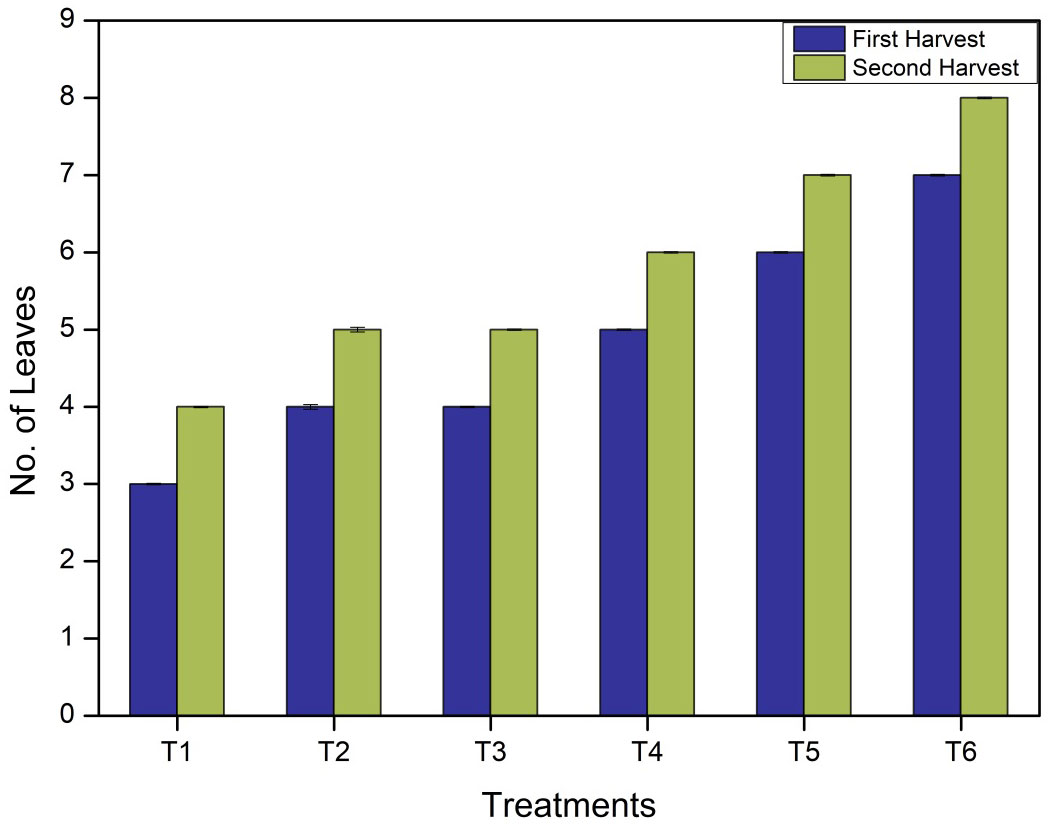
Figure 4 Number of leaves at the first and second harvesting stages of Vigna radiata plants (bars represent the standard deviation).
Similar to the number of leaves per plant, the leaf area was also significantly affected by the nitrogen rates. The plant with the maximum leaf area may also have higher photosynthesis because of increased nutrition during the growth stages. The maximum leaf area was recorded in the T6 treatment i.e., 7.12 cm2 in the first harvesting stage and 8.94 cm2 in the second harvesting stage, whereas the minimum leaf area (3 cm2 in the first harvesting stage and 4.5 cm2 in the second harvesting stage) was obtained in the control (T1) with no fertilizer applied. Other treatments showed leaf areas of 4.4 cm2 in T2, 4.8 cm2 in T3, 5 cm2 in T4, and 6.5 cm2 in T5 in the first harvesting, followed by the second harvesting, which showed 5.5 cm2 in T2, 5.5 cm2 in T3, 5.8 cm2 in T4, and 7.6 cm2 in T5 (Figure 5). Thus, the mean leaf area was observed to increase with the controlled-release fertilizer using CNF*N. Interestingly, there was only a marginal difference among the control T1 and T3 (bulk ammonium chloride), whereas no significant differences in parameters between the T2 (cellulose nanofibre pellet), T3 (bulk ammonium chloride), and T4 (CNF*N, 10 mg) were observed. A significant improvement was obtained with increasing the dosage of the CNF*N from 10 mg to 50 mg. An exponential increase was observed in the leaf area, i.e., from ~3 to ~7.1 cm2 in the first harvest and ~ 4.5 to~ 8.9 cm2 in the second harvest.
The results indicated that the number of primary branches was significantly affected by the addition of N-fertilizer. Notably, the highest numbers of primary branches (4 in the first harvesting stage and 7 in the second harvesting stage) were recorded in T6 treatment as compared to the control (T1) (2 in first harvesting stage and 4 in second harvesting stage), where no fertilizer was applied. Other treatments showed primary branches of 4.4 cm2 in T2, 4.8 cm2 in T3, 5 cm2 in T4, and 6.5 cm2 in T5 in first harvesting, followed by second harvesting, which showed 5.5 cm2 in T2, 5.5 cm2 in T3, 5.8 cm2 in T4, and 7.6 cm2 in T5. This implied that higher vegetative growth was achieved when there was a higher availability of nutrients due to the controlled delivery of the fertilizer via a CNF-based N-fertilizer formulation.
The soil nutrient contents were monitored during the two post-harvest stages (45 days and 90 days) of the mung bean cultivation, as shown in Table 4. No significant difference was observed in the soil pH and organic carbon content among the controls (T1, T2) and the treatments (T3-T6) that were given to the mung plant [34]. In this study, the slight basic pH, which causes the continual removal of NH4+ ions from the nitrogen-fertilizer loaded CNF and neutralizes the hydronium ions (OH-) in the soil, favors the equilibrium shift, making the process self-propagating. Further, the CNF in the later stage will be depolymerized by microbes into oligomers or dimers, which serve as carbon sources for the plant and further contribute to plant yield (Zhou et al., 2011).
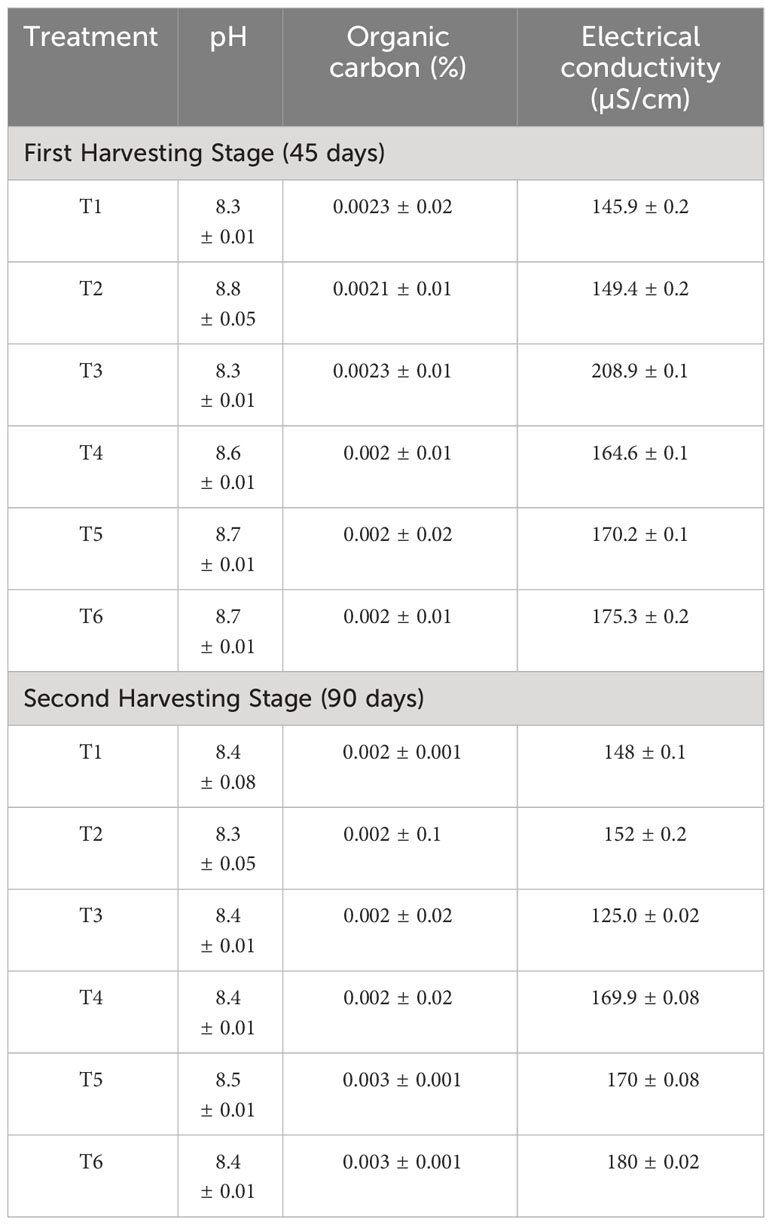
Table 4 Physico-chemical parameters of soil after the first and second harvesting stages of Vigna radiata.
The electric conductivity was highest in the T3 treatment as compared to the other treatments and ranged from 145 to 175 µS/cm. The maximum EC in treatment 3 (T3) in the first harvesting stage was observed as the ammonium chloride was added to the soil in bulk during the treatment. The electrical conductivity increased with the solubilization of water-soluble ammonium chloride fertilizer which also increased the salt levels in the soil. As a major portion of the ammonium chloride added was already released or leaked until the first harvesting stage, the EC values of the T3 treatment decreased after the first harvesting stage. During the second harvesting stage, the EC was found to be in the range of 125 to 180 µS/cm. The maximum EC was found in T6, owing to the controlled-release of nitrogen-fertilizer loaded onto CNF.
The nutrient nitrogen (N) is essential for plant growth and the overall yield of the crop. Significantly higher nitrogen content (available and total) was observed in the CNF*N treatments (T4, T5, and T6) as compared with the negative control treatments (T1, T2) and positive control treatment (T3) during the first harvesting stage (45 days). The positive control was bulk fertilizer that was highly soluble in water and released during the initial growing phase, whereas the CNF*N treatments showed controlled release of nitrogen until the 45th day with maximum concentrations. Similarly, in the second harvesting stage, the soil components, mainly nitrogen, were analyzed for all the treatments to determine the nutrient contents in the soil. Nitrogen content was highest in the T6 treatment as compared to the control. The nitrogen content in T3 treatment where commercially available ammonium chloride was added in bulk was less, as ammonium chloride was highly soluble in water, so there are probably more chances of leakage of the salt in free form as compared to the salt loaded on CNF. Similar pattern was observed in the entire greenhouse study, where the maximum soil nutrients, plant height, leaf area, and other growth parameters were found in nitrogen-fertilizer loaded CNF treatments (T4, T5, and T6). Treatments T4, T5, and T6 were observed to represent no deficiency in the soil nutrient (nitrogen), which was attributed to the substantial release of sufficient quantities of nitrogen from the designed CNF*N formulation even after 90 days of the second harvesting. This observation was attributed to the controlled-release of nitrogen-fertilizer loaded onto the CNF, which regulates and improves the nutrient uptake efficiency of the plant via the controlled release of nutrient, as shown in Figure 6.

Figure 6 Percentage of nitrogen contents in soil: (A) first harvesting stage; (B) second harvesting stage of Vigna radiata (bars represent the standard deviation).
The results were further corroborated by the yellowing of leaves in treatments T1, T2, and T3 after 90 days of the growing phase (Figures 3A–F) which indicated the lesser availability of nitrogen in the T3 treatment, where commercial ammonium chloride added in bulk was prone to microbial immobilization or leaching losses, whereas the T1 and T2 treatments were without any fertilizer, one propagating with only on the original soil and the other on soil with unloaded CNF. However, the treatments T4-T6 with controlled-release N-fertilizer loaded CNF at nitrogen loadings comparable to T3 did not show such manifestations anytime during the 90 days growth period.
Thus, the formulated CNF*N (nitrogen-fertilizer loaded CNF) appeared as a controlled-release fertilizer system that maintained the nitrogen content even after 90 days of harvesting. The results indicate that the nitrogen content in the soil was high in the replicates treated with the formulation, and hence the designed formulation could be utilized as an alternative to the commercial fertilizer, which had to be applied in bulk and was hence prone to volatization and leaching, leading to poor adsorption by the plants.
The controlled release fertilizers are the smartest tools for sustainable agriculture. However, the impact of controlled release fertilizer on crops must be carefully evaluated before field implementation (Sharma et al., 2023a). The physiochemical parameter of soil plays critical role for plant growth (Yin et al., 2018). Numerous studies showed fertilizer impact on Vigna radiate. A report by Mota et al. showed the dosage of NPS (150 kg) per hectare on Vigna radiata, where the Shewa Robit variety showed maximum growth of the plant around 67.75 cm, whereas the minimum height of 59.0 cm was obtained in plants without additional fertilizer. Therefore, the causes of the maximum plant height were the genetic differences between varieties and enhanced NPS fertilizer. It could also be the result of a climate that is favourable up to physiological maturity, particularly when it comes to timely rainfall throughout the growth season (Khandare et al., 2020). According to another report, nitrogen plays a critical role in stimulating vegetative growth, thus impacting the overall yield of the plant (Chen et al., 2018).
A report by Khandare et al. observed plant dry matter of about 10.8 and 10.5 g/plant, both with 75% NP + liquid inoculation (Azotobacter-PSB; 625 mL/ha) and 75% NP + carrier inoculation (Azotobacter-PSB; 10 kg/ha), respectively (Alori et al., 2017), which indicated the carrier was beneficial to the plant. A report by Chen et al., showed that a moderate rate of nitrogen-fertilization plays a crucial role in root elongation, increasing surface area and volume in soil. The entire length of the root was found to grow to 25 cm using the minirhizotron method (Houmani et al., 2015).
The plant roots also play a critical role in maintaining the rhizosphere environment, as root exudate releases organic acids and protons (H+). The rhizosphere in the soil plays an essential role in facilitating the interaction between plant roots and microbes, which further enhances the mineralization of nitrogen and further enhances the plant’s net nitrogen assimilation (Dong et al., 2008; Karuku, 2019; Sharma et al., 2023c). Multiple studies have shown that the overall chlorophyll content in the leaves increased with excessive application of nitrogen-fertilizer but it may impact the carbon and nitrogen metabolism within the soil. Thus, under high nitrogen-fertilizer concentration the root growth was impacted, but the leaf numbers were increased (Kawte et al., 2020; Wang et al., 2020). An increased number of branches of plant indicated improved growth, which is the result of sufficient availability of nutrients at growth stages leading to efficient photosynthetic activity (Zhou et al., 2011). A similar study was conducted by Fernandes et al., where the water-soluble fertilizer showed a maximum EC of approximately 3 dS/m (Fernandes de Oliveira Braghin et al., 2019).
Thus, the utilization of CNF-based controlled-release fertilizer has proven to be highly effective in promoting the growth and development of Vigna radiata plants. The controlled release mechanism ensures a sustained and balanced supply of nutrients, optimizing nutrient uptake by the plants. This approach not only enhances the overall yield of Vigna radiata but also contributes to resource efficiency and environmental sustainability. The results suggest that CNF-based controlled release fertilizers can be a promising strategy for improving crop productivity while minimizing the environmental impact associated with traditional fertilization methods.
The performance of CNF*N controlled-release fertilizer has not only slowed down the nutrient release to the soil but also improved the soil fertility profile with the polymerization of CNF that will be utilized by microbes. The results of the study showed that plant height was highest in T6 treatment (44.4 ± 0.1 cm), whereas the less plant height was observed in T1, which was 39.1 ± 0.1 cm, after second harvesting, and the root-to-shoot ratio was maximum in T6 (0.183± 0.02) and minimum in T1 (0.07± 0.01) after second harvesting. This suggested the controlled-release of nitrogen-fertilizers tuned in accordance with the plant’s requirement for nitrogen. Thus, a CNF-based controlled fertilizer system could be adopted as an eco-friendly and biodegradable alternative to the practice of commercial application of the fertilizers by broadcasting, which otherwise leads to nutrients leaching to the water bodies, limited absorption by plants, and thus causing eutrophication and serious health hazards.
The original contributions presented in the study are included in the article/Supplementary Material. Further inquiries can be directed to the corresponding author.
NS: Conceptualization, Data curation, Formal analysis, Investigation, Methodology, Writing – original draft, Writing – review & editing. MK: Project administration, Resources, Supervision, Validation, Visualization, Writing – review & editing. BA: Supervision, Validation, Writing – review & editing. RR: Project administration, Supervision, Validation, Writing – review & editing. RA: Project administration, Supervision, Validation, Visualization, Writing – review & editing.
The author(s) declare that no financial support was received for the research, authorship, and/or publication of this article.
The authors are thankful to Deakin University, Geelong, Australia, TERI-Deakin Nanobiotechnology Center (TDNBC), Sustainable Agriculture Programme, The Energy and Resources Institute (TERI), India for providing financial support. The authors would also like to thank Dr Leena Johny (Associate Fellow) for providing resources for the pot study and Mrs. Ashita Anand Abrol for assisting in plant harvesting.
The authors declare that the research was conducted in the absence of any commercial or financial relationships that could be construed as a potential conflict of interest.
All claims expressed in this article are solely those of the authors and do not necessarily represent those of their affiliated organizations, or those of the publisher, the editors and the reviewers. Any product that may be evaluated in this article, or claim that may be made by its manufacturer, is not guaranteed or endorsed by the publisher.
The Supplementary Material for this article can be found online at: https://www.frontiersin.org/articles/10.3389/fpls.2024.1336884/full#supplementary-material
Alemu, I. D. (2016). General Characteristics and Genetic Improvement Status of moong (Vigna radiata L.) in Ethiopia. Int. J. Agric. Innov. Res. 5 (2), 232–237. http://www.ijair.org/index.php/issues?view=publication&task=show&id=811.
Alori, E. T., Glick, B. R., Babalola, O. O. (2017). Microbial phosphorus solubilization and its potential for use in sustainable agriculture. Front. Microbiol. 8, 971. doi: 10.3389/fmicb.2017.00971
Asaduzzaman, M., Karim, M. F., Ullah, M. J., Hasanuzzaman, M. (2008). Response of mungbean (Vigna radiata L.) to nitrogen and irrigation management. American-Eurasian J. Sci. Res. 3 (1), 40–43.
Chen, J., Liu, L. T., Wang, Z. B., Sun, H. C., Zhang, Y. J., Lu, Z. Y., et al. (2018). Determining the effects of nitrogen rate on cotton root growth and distribution with soil cores and minirhizotrons. PloS One 13, e0197284. doi: 10.1371/journal.pone.0197284
Cheng, X. Z. (2016). Vigna radiata production technology books (Beijing: China Agricultural Publishing House).
Dong, H. Z., Niu, Y., Li, W., Zhang, D. (2008). Effects of cotton root stock on endogenous cytokinins and abscisic acid in xylem sap and leaves in relation to leaf senescence. J. Exp. Bot. 59, 1295–1304. doi: 10.1093/jxb/ern035
Fernandes de Oliveira Braghin, S., Mello, S. C., Angelotti-Mendonça, J., Minami, K., Li, Y. C. (2019). Controlled-release fertilizers improved croton growth and reduced nitrogen leaching. HortSci. horts 54 (12), 2224–2230. doi: 10.21273/HORTSCI14361-19
He, J., Reddy, G. V. P., Liu, M., Shi, P. (2020). A general formula for calculating surface area of the similarly shaped leaves: Evidence from six Magnoliaceae species. Global Ecol. Conserv. 23, e01129. doi: 10.1016/j.gecco.2020.e01129
Houmani, H., Rabhi, M., Abdelly, C., Debez, A. (2015). “Implication of rhizosphere acidification in nutrient uptake by plants: Cases of potassium (K), phosphorous (P) and iron (Fe),” in crop production and global environmental issues. Ed. Hakeem, K. R. (Cham, Switzerland: Springer), 103–111. Available at: http://www.nafis.go.ke/vegetables/kales/.
Hua, J. I. (2006). Nutritional value and comprehensive utilization of Vigna radiata. Prog. Modern Biomed. 10, 143–144.
Hussain, F., Malik, A. U., Haji, M. A., Malghani, A. L. (2011). Growth and yield response of two cultivars of mungbean (Vigna radiata L.) to different potassium levels. J. Anim. Plant Sci. 21 (03), 622–625.
Ikraam, M. (2002). Influence of different fertilizer levels on the growth and productivity of three mungbean (Vigna radiata L.) cultivars. Int. J. Agric. Biol. 3, 335–338.
Jain, A. K., Kumar, S., Panwar, J. (2007). Response of Vigna radiata (Vigna radiate L.) to phosphorus and micronutrients on N and P uptake and seed quality. Legume Res. 30 (3), 201–204.
Karuku, G. N. (2019). Effect of lime, N and P salts on nitrogen mineralization, nitrification process and priming effect in three soil types, Andosols, Luvisols and Ferralsols. J. Agric. Sustainabil. 12, 74–106.
Kawte, K., Dereje, S., Mesfin, B. (2020). Performance of mungbean (Vigna radiata L.) varieties at different NPS rates and row spacing at Kindo Koysha district, Southern Ethiopia. Cogent Food Agric. 6, 1–12. doi: 10.1080/23311932.2020.1771112
Khandare, R. N., Chandra, R., Pareek, N., Raverkar, K. P. (2020). Carrier-based and liquid bioinoculants of Azotobacter and PSB saved chemical fertilizers in wheat (Triticum aestivum L.) and enhanced soil biological properties in Mollisols. J. Plant Nutr. 43, 36–50. doi: 10.1080/01904167.2019.1659333
Krishnamoorthy, V., Rajiv, S. (2017). An eco-friendly top-down approach to nutrient incorporated Electrospun seed coating for superior germination potential. J. Adv. App. Sci. Res. 1 (7). doi: 10.46947/joaasr17201754
Lelago, A., Mamo, T., Haile, W., Shiferaw, H. (2016). Assessment and mapping of status and spatial distribution of soil macronutrients in Kambata Tembaro zone, Southern Ethiopia. Adv. Plant Agric. Res. 4, 00144. doi: 10.15406/apar.2016.04.00144
Mota, F. M., Balla, D. S., Doda, M. B. (2021). Response of Vigna radiata Varieties (Vigna radiata L.) to Application Rates and Methods of Blended NPS Fertilizer at Humbo. Int. J. Agron. 3786720. doi: 10.1155/2021/3786720
Naeem, M., Iqbal, J., Ahmad, M. A. (2006). Comparative study of inorganic fertilizers and organic manures on yield and yield components of mungbean (Vigna radiate L.). J. Agric. Soc. Sci. 4, 227–229.
Nair, R. M., Pandey, A. K., War, A. R., Hanumantharao, B., Shwe, T., Alam, A., et al. (2019). Biotic and abiotic constraints in mungbean production—Progress in genetic improvement. Front. Plant Sci. 10. doi: 10.3389/fpls.2019.01340
Potdar, R. P., Shirolkar, M. M., Verma, A. J., More, P. S., Kulkarni, A. (2021). Determination of soil nutrients (NPK) using optical methods: a mini review. J. Plant Nutr. 44 (12), 1826–1839. doi: 10.1080/01904167.2021.1884702
Sadeghipour, O., Monem, R., Tajali, A. A. (2010). Production of mungbean (Vigna radiata L.) as affected by nitrogen and phosphorus fertilizer application. J. Appl. Sci. 10 (10), 843–847. doi: 10.3923/jas.2010.843.847
Sharma, N., Aallardyce, B., Rajkhowa, R., Agrawal, R. (2023a). Controlled release fertilizer delivery system derived from rice straw cellulose nanofibres: a circular economy based solution for sustainable development. Bioengineered 14 (1). doi: 10.1080/21655979.2023.2242124
Sharma, N., Aallardyce, B., Rajkhowa, R., Agrawal, R. (2023b). Delivery of agrochemicals and nutrients through a biopolymer−Based system derived from lignocellulosic rice straw. J. Polymers Environ. doi: 10.1007/s10924-023-02893-z
Sharma, N., Kochar, M., Aallardyce, B., Rajkhowa, R., Agrawal, R. (2023c). Biodegradation of N-fertilizer loaded on cellulose nanofibres to assess their potential use as a controlled-release fertilizer. J. mater. Sci. doi: 10.1007/s10853-023-09134-7
Sharma, N., Lavania, M., Lal, B. (2020). Development and demonstration of membrane to control potential pathogen (Legionella sp.) associated with cooling towers. Front. Environ. Sci. 8. doi: 10.3389/fenvs.2020.570904
Shojaei, T. R., Salleh, M. A. M., Tabatabaei, M., Mobli, H., Aghbashlo, M., Rashid, S. A., et al. (2019). “Applications of nanotechnology and carbon nanoparticles in agriculture,” in Synthesis, Technology and Applications of Carbon Nanomaterials. Eds. Suraya, A. R., Raja, N. I. R. O., Mohd, Z. H. (Amsterdam: Elsevier), 247–277.
Wang, L., Yang, L., Xiong, F., Nie, X., Li, C., Xiao, Y., et al. (2020). Nitrogen fertilizer levels affect the growth and quality parameters of astragalus mongolica. Molecules 25 (2), 381. doi: 10.3390/molecules25020381
Yanni, Y. G., Rizk, R. Y., Elfattah, F. K. A., Squartini, A., Viviana, C., Alessio, G., et al. (2001). The beneficial plant growthpromoting association of rhizobium leguminosarum bv. trifolii with rice roots. Funct. Plant Biol. 28 (9), 845–870. doi: 10.1071/PP01069
Yayeh, S. G., Alemayehu, M., Haileslassie, A., Dessalegn, Y. (2017). Economic and agronomic optimum rates of NPS fertilizer for irrigated garlic (Allium sativum L) production in the highlands of Ethiopia. Cogent Food Agric. 3, 1333666. doi: 10.1080/23311932.2017.1333666
Yin, Z., Guo, W., Xiao, H., Liang, J., Hao, X., Dong, N., et al. (2018). Nitrogen, phosphorus, and potassium fertilization to achieve expected yield and improve yield components of Vigna radiata. PloS One 13 (10), e0206285. doi: 10.1371/journal.pone.0206285
Keywords: ammonium chloride-fertilizer, CNF, controlled-release fertilizer, Vigna radiata, plant growth, soil nutrient
Citation: Sharma N, Kochar M, Allardyce BJ, Rajkhowa R and Agrawal R (2024) Unveiling the potential of cellulose nanofibre based nitrogen fertilizer and its transformative effect on Vigna radiata (Mung Bean): nanofibre for sustainable agriculture. Front. Plant Sci. 15:1336884. doi: 10.3389/fpls.2024.1336884
Received: 11 November 2023; Accepted: 15 January 2024;
Published: 31 January 2024.
Edited by:
Miroslav Zoric, LoginEKO Research and Development Center, SerbiaReviewed by:
Suresh Kaushik, Independent researcher, New Delhi, IndiaCopyright © 2024 Sharma, Kochar, Allardyce, Rajkhowa and Agrawal. This is an open-access article distributed under the terms of the Creative Commons Attribution License (CC BY). The use, distribution or reproduction in other forums is permitted, provided the original author(s) and the copyright owner(s) are credited and that the original publication in this journal is cited, in accordance with accepted academic practice. No use, distribution or reproduction is permitted which does not comply with these terms.
*Correspondence: Ruchi Agrawal, cnVjaGkuYWdyYXdhbEB0ZXJpLnJlcy5pbg==
Disclaimer: All claims expressed in this article are solely those of the authors and do not necessarily represent those of their affiliated organizations, or those of the publisher, the editors and the reviewers. Any product that may be evaluated in this article or claim that may be made by its manufacturer is not guaranteed or endorsed by the publisher.
Research integrity at Frontiers

Learn more about the work of our research integrity team to safeguard the quality of each article we publish.